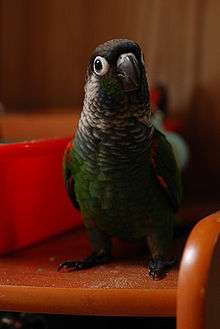Pearly parakeet
The pearly parakeet (Pyrrhura lepida), more commonly known as the pearly conure in aviculture, is a species of parrot that is endemic to east Amazonian forests in Brazil.[2]
| Pearly parakeet | |
|---|---|
 | |
| Scientific classification | |
| Kingdom: | Animalia |
| Phylum: | Chordata |
| Class: | Aves |
| Order: | Psittaciformes |
| Family: | Psittacidae |
| Genus: | Pyrrhura |
| Species: | P. lepida |
| Binomial name | |
| Pyrrhura lepida (Wagler, 1832) | |
Taxonomy
Its taxonomic history is potentially confusing. It was formerly known as Pyrrhura perlata, but following a review it was discovered that the type specimen, long believed to belong to this species, actually was a juvenile of the closely related crimson-bellied parakeet. Consequently, P. perlata was transferred to that species, while the next name in line for the pearly parakeet, P. lepida, became its valid scientific name.[2]
Traditionally, three subspecies of the pearly parakeet have been recognized: Western anerythra, eastern nominate lepida, and far eastern coerulescens.[2] In 2011, a review found that lepida and coerulescens were inseparable (both have some red to the wings and virtually no red to the belly in adults). This would usually result in coerulescens being a junior synonym of the older name lepida, but upon closer inspection the type specimen of the latter is a hybrid. This invalidates the name lepida and leaves coerulescens as the valid name for the population east of the Tocantins–Araguaia River, including Marajo Island.[3] In contrast, anerythra is highly distinctive (lacks red to the wings, but has some reddish to the belly) and it has been recommended it should be treated as a separate, monotypic species found between the Xingu River and Tocantins–Araguaia River.[3] There is limited hybridization between coerulescens and anerythra where the two come into contact in the Portel, Pará region.[3]
Status
The pearly parakeet is rated as Vulnerable by the IUCN.[1] While it remains locally fairly common, it has suffered due to extensive habitat destruction, especially in the eastern part of its range where the subspecies coerulescens (if recognized as valid) may be approaching extinction.[1][2]
References
- BirdLife International (2012). "Pyrrhura lepida". IUCN Red List of Threatened Species. 2012. Retrieved 26 November 2013.CS1 maint: ref=harv (link)
- Collar, N. J. (1997). Pearly Parakeet (Pyrrhura lepida). Pp. 440 in: del Hoyo, J., Elliott, A., & Sargatal, J. eds. (1997). Handbook of the Birds of the World. Vol. 4. Sandgrouse to Cuckoos. Lynx Edicions, Barcelona. ISBN 84-87334-22-9
- Somenzari, M. (2011). Taxonomia do complex Pyrrhura lepida (Aves: Psittacidae). Instituto de Biociências, São Paulo.
